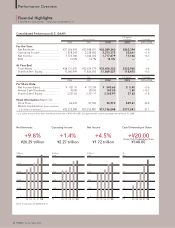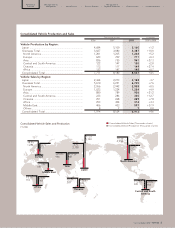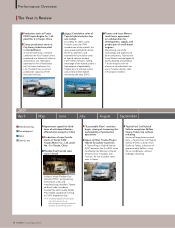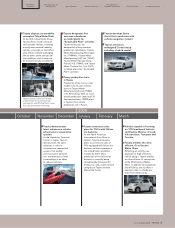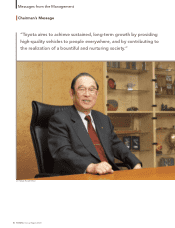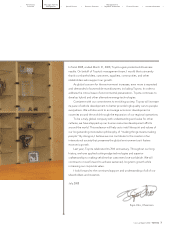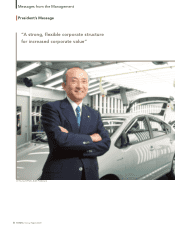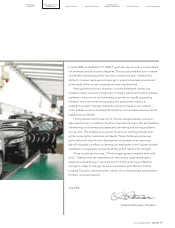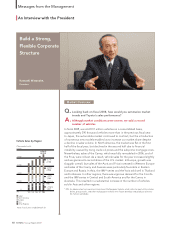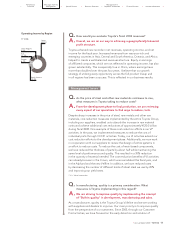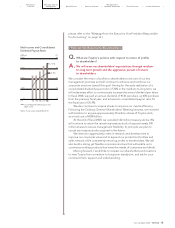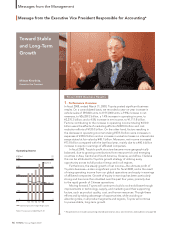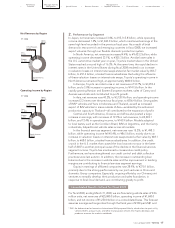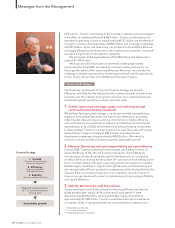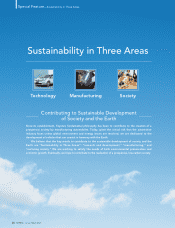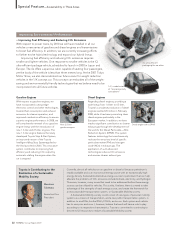Toyota 2008 Annual Report Download - page 14
Download and view the complete annual report
Please find page 14 of the 2008 Toyota annual report below. You can navigate through the pages in the report by either clicking on the pages listed below, or by using the keyword search tool below to find specific information within the annual report.
12 TOYOTA •Annual Report 2008 •
problems to prevent them from appearing in products on the market.
“Built-in quality” takes this even further. It assures that quality is built-in
during each process, so that only the highest quality is passed on to the next
process. In the event that a problem occurs during a particular process,
the cause is investigated and design plans, facilities and management
conditions are reviewed. This ensures that our improvement cycle can also
be implemented in upstream processes. This approach has been adopted
not only in manufacturing, but also in development, sales and service, and
management, leading to a marked decline in the number of initial quality
claims in new models. In the future, we intend to strengthen our efforts
overseas in this regard.
Q.What measures is Toyota implementing to develop global human
resources?
A.We are establishing Global Production Centers (GPCs) worldwide
to develop global human resources.
Currently, the Toyota Group includes 53 production sites in 27 countries and
regions, with sales operations in over 170 countries and regions. With such
geographic diversity, we need to advance human resources development
globally. We established a GPC at our Motomachi plant to pass Toyota’s
unique culture and values on to all employees and enable them to
understand the Toyota Way. The GPC developed intensive technical training
systems that enable personnel to gain an understanding of advanced skills in
a short period of time. In the five years since the GPC opened, more than
10,000 employees from Japan and abroad have learned about our
philosophy and technologies. They then pass on this knowledge to staff
members at their respective places of employment worldwide. We have also
established GPCs in the United States, the United Kingdom, and Thailand to
further promote the development of human resources. We are also pursuing
the Toyota Way for sales and marketing activities through the kaizen process
of our Global Knowledge Center (GKC)—established in 2002—and by sharing
best practices with distributors and dealers worldwide. In addition, to develop
human resources in management, in 2001 we established the Toyota Institute,
where executive candidates and members of middle management are
trained in putting the Toyota Way into practice.
Q.What are Toyota’s vehicle sales strategies for the future?
A.We will strive to increase our sales volume by meeting demand
in resource-rich and emerging countries.
Recent economic growth has caused automotive markets in resource-rich
and emerging countries to grow rapidly, enabling Toyota to record a
dramatic increase in sales. Taking advantage of our strengths as an
automobile manufacturer with a full lineup of models ranging from
minivehicles to SUVs and luxury cars, we will strive to grow our sales in
these markets by introducing products that meet diverse regional needs.
Growth Strategies
Messages from the Management


